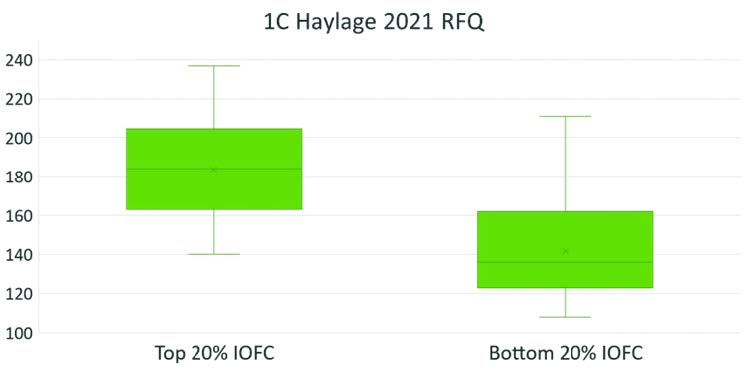Grand Valley Fortifiers, Nutrition Direct
There are many factors that IOFC does not account for. These factors include whether a producer is currently filling quota, labour efficiency, total herd inventory, or the effectiveness of the reproduction program on farm. What IOFC does bring us is an answer to a specific question when comparing to different ration options or between different herds: Am I currently feeding the most nutritionally efficient milk cow ration right now? If not, is there a profitable path to increasing this specific metric? With this case study, we found that there was an astounding $10/cow/ day difference in IOFC when comparing the top 20% group and the bottom 20% group. To put that into context, for two farms both milking 100 cows, that would be a $365,000 difference in profit over the course of a year! So, what are some of the differences, from a nutrition perspective, that lead to this vast difference in profitability between different farms?
The top 20% of farms for IOFC are more likely (70% vs 50% of farms) to feed homegrown grain (such as high moisture corn or cob meal) rather than purchased energy concentrates such as dry ground corn. This factor is very intuitive as the cost to grow and store grain will be more cost effective than buying it in, resulting in a decreased level of total feed costs for the same nutritional ingredient. Note that for producers without enough land base to grow their own grains, this is not an easy problem to fix due to the price and scarcity of land. The next point is more attainable for all producers.

The top IOFC group feeds an average of 65% corn silage diets, as a percentage of total ration forage dry matter. The bottom group tends to be more around 50%. Why go high corn silage for milk cows? Good quality corn silage results in consistent rations with less undigestible fibre (uNDF) and high palatability resulting in higher dry matter intakes which produces more milk and/or components. Corn silage also brings a highly fermentable source of starch that can fire up the rumen bugs to allow them to build the most cost-efficient protein available, which might even help reduce the amount of purchased protein you need, if the cow can make it herself.

2021 Corn Silage tended be higher (40% vs 35% starch) for the top vs bottom IOFC groups. Although 35% starch silage is generally considered a respectable level of starch to get off the field in an average year, the top 20% herds are managing to bring in even more starch into their silage. While the top group is feeding high levels of high starch corn silage paired with modest levels of home-grown grain corn, the bottom group will be buying in large amounts of purchased corn to pair with the low level of medium starch corn silage in their diets.


Relative Forage Quality (RFQ) is favoured as a metric when discussing haylage quality as it helps to compare quality among variety groups such as straight alfalfa, mixed, or pure grass haylages, which are all perfectly valid variety groups to feed to milk cows. This index is based on factors such as protein, sugars, fibre levels, as well as fibre digestibility. For 2021 first cut haylage, RFQ was significantly higher in the top IOFC group (185 RFQ) vs the bottom group (135 RFQ). Just like corn silage, the top group is getting the ability to deploy these high-quality nutrients and eating potential to drive milk to new heights as well as cutting back on the amount of purchased protein and corn needed to balance. You may get to the end of this list and wonder why so much focus must be spent on some of the most basic elements of providing feed for dairy cows. The answer, based on real data, is quite simply that there is so much
Relative Forage Quality (RFQ) is favoured as a metric when discussing haylage quality as it helps to compare quality among variety groups such as straight alfalfa, mixed, or pure grass haylages, which are all perfectly valid variety groups to feed to milk cows. This index is based on factors such as protein, sugars, fibre levels, as well as fibre digestibility. For 2021 first cut haylage, RFQ was significantly higher in the top IOFC group (185 RFQ) vs the bottom group (135 RFQ). Just like corn silage, the top group is getting the ability to deploy these high-quality nutrients and eating potential to drive milk to new heights as well as cutting back on the amount of purchased protein and corn needed to balance. You may get to the end of this list and wonder why so much focus must be spent on some of the most basic elements of providing feed for dairy cows. The answer, based on real data, is quite simply that there is so much

This article was written for the Summer 2022 Dairy Eastern Dairy Grist. To read the whole Dairy Grist, click the button below.

